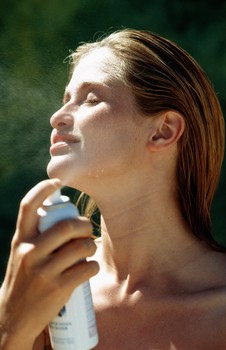Cancer
| Although researchers are investigating multiple new strategies to prevent and treat melanoma and other skin cancers, the most effective strategy is to avoid unnecessary exposure to the sun and eliminate recreational tanning altogether.
There is no such thing as a good tan; a tan means there is damage. |
 |
 |
Too much sunlight can lead to basal cell carcinoma or squamous cell carcinoma – but it may lead to melanoma – the most deadly form of skin cancer. Melanoma accounts for only 5 percent of all skin cancer but 75 percent of all deaths. Basal cell carcinoma is the most common form and is rarely deadly. Squamous cell carcinoma occurs in roughly 16 percent of all cases. While it can often be treated successfully, it, too, can occasionally spread and be fatal. Over the last century, there has been a steady increase in the number of non-melanoma skin cancers, with over 1 million cases reported last year in the United States. |
Most people are under the mistaken notion that if they go outside in the sun that a plain, white T-shirt will protect them. It won’t. A plain white T-shirt is equal to approximately an SPF (sun protection factor) of 2. A wet white T-shirt offers an SPF of 0!
The best thing for people to do is avoid the sun as much as possible, or, if they have to be outside, wear plenty of sunscreen with a high SPF value. Importantly, you must reapply the sunscreen. Even sunscreens that are labeled waterproof will wear off over time. Children are especially vulnerable to skin damage, so it is critical that they be adequately protected. Sun protection isn’t just for the summer months either. Outdoor activities in the winter such as skiing or sledding also expose unprotected facial skin to dangerous UV rays. This means that sunscreen use is something that should be done year round.
Skin cancer is one type of malignancy that, for the most part, we know how to prevent. It’s only a matter of following through. In addition to avoiding too much sun, beginning a lifelong habit of self-examination is critical for protection from skin cancer. Follow the American Cancer Society guidelines for self-examination, referred to as the “ABCD” rules, regarding any changes in moles or growths:
- A is for ASYMMETRY: One-half of the mole or birthmark does not match the other.
- B is for BORDER: The edges are irregular or ragged-looking.
- C is for COLOR: The color is not the same all over, but may appear patchy, with differing shades of brown, black, red, white or blue.
- D is for DIAMETER: The area is larger than about one-fourth inch – the size of a pencil eraser – or is growing larger.
| Find out more: Sun-Safe Strategies to Prevent Skin Cancer – OSU Media Relations office Requires Windows Media Player |
This article is based on information provided by –> the previously asked questions
Last Reviewed: Nov 16, 2009

|
–> Associate Professor Department of Pathology Comprehensive Cancer Center James Cancer Hospital & Solove Research Institute The Ohio State University |
–> |